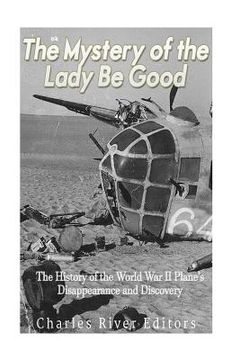The Mystery of the Lady Be Good: The History of the World War II Plane's Disappearance and Discovery (en Inglés)
Reseña del libro "The Mystery of the Lady Be Good: The History of the World War II Plane's Disappearance and Discovery (en Inglés)"
*Includes pictures *Includes accounts of the Lady Be Good's fateful mission *Includes online resources and a bibliography for further reading "Things pretty well mixed up. Got lost returning, out of gas, jumped, landed in the desert at 2 a.m. in the morning." - Excerpt from a log kept by 2nd Lieutenant Robert F. Toner of the Lady Be Good Nazi Germany's North African defeat opened up the possibility of taking the war in the west to the European continent for the first time since France's lightning conquest by the Wehrmacht in 1940. The British and Americans debated the merits of landing in France directly in 1943, but they ultimately opted against it. The Soviets railed at the Westerners as "bastards of allies" - conveniently forgetting that they aided and abetted Hitler's violent expansionism in eastern Europe for over a year, starting in 1939 - but a 1943 "D-Day" style landing in France might have proven a strategic and logistical impossibility. Complex reasons lay behind England's successful insistence on the Mediterranean theater rather than the French theater as the scene of the next western Allied strike against Nazi Germany. Chief among these remained Britain's determination to keep a postwar empire, one that Churchill and his cabinet hoped would include Iraq and Iran, the source of oil needed to ensure that England continued to "rule the waves" with a powerful modern navy. This strategic imperative, indeed, formed the backbone of the British choice of Sicily as the target for military operations in the summer of 1943. Naturally, the preparations also included bombing missions over Italy ahead of an amphibious landing, and on April 4, 1943, one of the planes that took off from Libya to bomb Naples was the Lady Be Good, a B-24D Liberator bomber with a crew that had never flown a combat mission. The operation, which included over a dozen planes, was undone by poor flying conditions almost from the start, and the Lady Be Good never even made into formation with the others attacking Naples, thus flying out the mission on its own. Around midnight, pilot 1st Lt William J. Hatton radioed for directions back to base, but after that, the plane and its crew were never heard from again. A search and rescue effort found nothing, and it would be over a decade before the remains of the plane, which many assumed went down in the Mediterranean, was found deep in the desert over 400 miles away from the base. The mystery further deepened when no human remains were found at the crash site, which suggested the crew had bailed out of the plane. Eventually, the remains of several members of the crew were found, and it led to the stunning discovery that multiple survivors undertook a desperate journey to safety before perishing in the desert, one that was actually documented in some of the men's diaries. The government's Mortuary Affairs concluded, "The aircraft flew on a 150 degree course toward Benina Airfield. The craft radioed for a directional reading from the HF/DF station at Benina and received a reading of 330 degrees from Benina. The actions of the pilot in flying 440 miles into the desert, however, indicate the navigator probably took a reciprocal reading off the back of the radio directional loop antenna from a position beyond and south of Benina but 'on course'. The pilot flew into the desert, thinking he was still over the Mediterranean."

